With Commentary by Joe Entrekin, Al Nyhus, and Randy Robinett
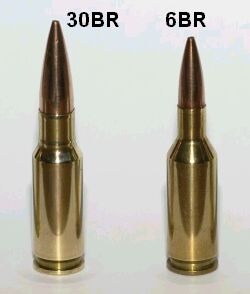
The 30BR now dominates 100, 200, and 300-yard Benchrest Score Competition. The larger .308 bullet diameter provides a clear advantage over the 22PPC and 6PPC in "best-edge" bullseye scoring. The 30BR has superb inherent accuracy. With H4198 or N130, one can easily find accurate, consistent 30BR loads with very little development time.
CLICK HERE for Reloading Info
The 30BR is forgiving and easy to tune. Top shooters can "set and forget" the 30BR since it holds its "tune" in a wide variety of conditions. Barrel life is 6000+ rounds. The 30BR is even more efficient than the 6BR. It can drive 120gr bullets faster than other cartridges, such as the 6.5-08, which burn 30% more powder.
Development of the 30BR Cartridge
by Randy Robinett
The origin of the .30BR is somewhat murky. In truth, the 30BR is much the same as a .308x1.50", or a .308 Barnes. Those cartridges have been around for decades. They were primarily used for "cast bullet" cartridges or handgun silhouette chamberings. As such, they were never considered suitable for serious Benchrest. Today, with our quality Lapua cases, precision hand-swaged bullets, and 1:18" twist barrels, I believe the full potential of thirty caliber precision is very nearly realized.
In 1998, gunsmith Ronnie Long, who had built two very successful 30x47 HBR "score" rifles, called and asked: "why won't a 30BR work?" Though he consistently trounced PPC shooters with his 18-twist Morrison-barreled 30x47 HBR, Ronnie was still searching for something better. At that time, Varmint for Score (VFS) was dominated by 6PPC shooters. Ronnie and I discussed the notion of necking up the overlooked 6mm BR case and decided to explore the possibilities. Ronnie ordered a reamer with the same freebore and throat as my proven .30x47 HBR reamer. He built a few guns, and shooters like "Smokin Joe" Entrekin started campaining them, with immediate success, in late 1999 and early 2000.
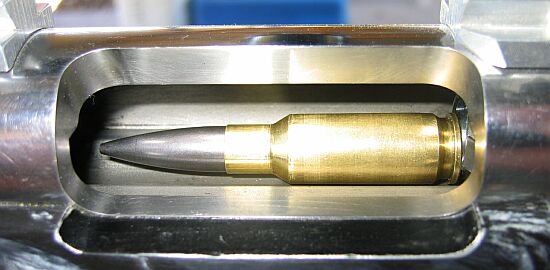
Meanwhile, at my home club's initial IBS Varmint for Score match, I let my friend Terry Meyer shoot my 30BR HV while I ran the event. A top-notch group shooter, Terry is VERY savvy when it comes to a rig's potential. After racking up the ONLY 250 score at 200-yards (and winning the match), Terry pronounced, "this is the beginning of the end for the PPC in score shooting". As they say, the rest is history!
Thus far, some talented shooters have used the 30BR chambering to claim ALL of the IBS National Championship VFS Grand Aggregate titles in 2003 and 2004. This includes successive 100/200 and 200/300 yard Score Championship wins. In the 30-caliber version, the "ugly duckling" BR case has finally found its rightful home in registered Benchrest Score competition--right next door to the PPC.
| One of the best things about the 30BR is its "no-brainer" tuning, so you can go to matches pre-loaded....Just find the load you're most comfortable with and go with it. Don't look back, and don't pay any attention to all the "experts" who try to tell you that the load has to be "tuned" for different conditions, like the 6PPC. The 30BR is a simple, practical, workhorse chambering compared to anything I've ever shot before, and I NEVER change the load.
-- Joe Entrekin, 2003 IBS Score Shooter of the Year -- |
The 30BR--Now King of the Hill in Score Shooting
by Joe Entrekin
The 30BR is not without its faults, but there are compelling reasons why it has quickly moved to the front of the field in Benchrest Score Shooting. First, the 30BR is very consistent and easy to tune. You don't have to load at the range or constantly mess with seating depths or charge weights. Find a good load and run with it. Second, I am firmly convinced that the 30BR equals the 6PPC in inherent accuracy. It just plain shoots. Combine that with the potential scoring advantage you get with a bigger bullet hole, and you've got a winner. What's the downside? Well, the extra recoil makes a 30BR gun harder to control than a 6PPC. But we've found that once people work out the right technique, they can master the recoil and eventually shoot better scores than they could with their PPCs.
When I first began score shooting competitively, I was using a 6BR that shot very well. However, some of my friends were shooting 30 X 47s in a bastardized club class called "Custom Hunter", and I couldn't help but notice those big ole holes they made in the targets. It's certainly easier to catch the center ring with a bigger hole. Well, after Randy Robinett and my gunsmith, Ronnie Long, had several lengthy conversations regarding the potential merits of the "new" 30BR, Ronnie asked if I had any interest in the 30. Being a curious and experimental sort, I thought the 30BR would be fun to try. Ronnie ordered three HV 30 cal 1:18 twist barrels from Krieger, one of which he fitted to my former 6BR rifle. Somehow, I wound up with another one of those barrels, and my friend and shooting partner, "Humble" Henry Rivers eventually got the 3rd one. (They have all been exceptional barrels. I am still shooting my barrel in competition, and with 7400 rounds through it, the barrel is still winning.)
I started shooting my 30BR in early 2000. It took awhile to figure out the ideal loads, but within a few months I was winning consistently at the local matches. This eventually convinced Henry to get a 30BR. "If you can't beat 'em, join 'em", right? His new 30BR rig shot great, whipping the PPCs with regularity. Enjoying considerable regional success in 2002, Henry and I decided to move up to the major National Matches. We did just that the next year, 2003, with both of us placing well at most of the matches we entered. I took second at the Bud Pryor Memorial Match in Thurmont, MD (the "30BR graveyard"), Henry won the 200/300 Nationals also at Thurmont, and I was awarded 2003 Score Shooter of the Year with Henry a very close second. We apparently turned enough heads in 2003 to start a revolution in score shooting, with a large number of 30BRs showing up for the 2004 season.
2004 was a banner year for 30BRs, and they continued to best the competition in Score Shooting. I won the Bud Pryor and the 100/200 Nationals. Clark Shen, shooting a pair of 30BRs, took the 200/300 Nationals in both VFS and Varmint Hunter. And this year Henry won Score Shooter of the Year, while I was the runner-up. Such match results speak for themselves; the 30BR is unquestionably THE dominant chambering in registered Benchrest score shooting. In just a few seasons, the 30BR has established itself as the cartridge to beat in Score competition, from 100 to 300 yards.
Joe Entrekin Full Article on 30BR in Competition
| 30BR Reloading, Case-Forming, and Technical Information |
30BR Case-Forming Procedure by Al Nyhus
The 30BR cartridge is formed by necking-up 6BR or 7BR brass. You can do this in multiple stages or
in one pass. Most of the top shooters prefer the single-pass method. You can use either an expander mandrel (like Joe Entrekin does), or a tapered button in a regular dies. Personally, I use a Redding tapered expander button, part number 16307. This expands the necks from 6mm to .30 cal in one pass. It works well as long as you lube the mandrel and the inside of the necks. I've also used the Sinclair expander body with a succession of larger mandrels, but this is a lot more work and the necks stay straighter with the Redding tapered button. This button can be used in any Redding die that has a large enough inside diameter to accept the BR case without any case-to-die contact.
Don't be concerned about how straight the necks are before firing them the first time. When you whap them with around 50,000 psi, they will straighten out just fine! I recommend not seating the bullets into the lands for the first firing, provided there is an adequate light crush-fit of the case in the chamber. The Lapua cases will shorten from approx. 1.550" to around 1.520" after being necked up to 30-caliber I trim to 1.500" with the (suggested) 1.520 length chambers. I don't deburr the flash holes or uniform the primer pockets until after the first firing. I use a Ron Hoehn flash hole deburring tool that indexes on the primer pocket, not through the case mouth.
Advanced Case Prep, Neck-Turning and Annealing by Joe Entrekin (Click for Full Article)
I do things a little different than Al does. I use a K&M Expandiron, specifically sized to neck up the case in one pass. I recommend you lube the mandrel with Imperial Die Wax or other premium lube. Once the case is expanded, you'll see a bulge or doughnut near the base of the neck. You'll need to turn the cases to remove this bulge. Proper neck-turning is the key to good concentricity. My chambers are .330", so I turn to .328", leaving a .010" neck-wall thickness. I also anneal my cases after expanding and neck-turning. I describe my case prep procedures in some detail, including sorting, neck-turning, annealing and accurizing. Click on the link above for the complete story.
Component Selection--Brass and Bullets by Al Nyhus
The 30BR cartridge begins as a 6mm BR or 7mm BR parent case. I recommend the Lapua 6BR brass, although the Remington 7BR cases have proven to be excellent as well. The Remington 7BR cases will be smaller .200 ahead of the extractor groove and at the body/shoulder junction than the Lapua and can show a slight bulge after firing. While this does not affect accuracy, it may cause sizing problems in that you are working the brass excessively. I have also had excellent luck with the Norma brand 6BR cases in my 6BR rifle and would expect that they would perform in the 30BR as well. The Remigton 6BR cases should be avoided, in my opinion, as they do not exhibit the quality of the Remighton 7BR brass. Bottom line--use Lapua brass.
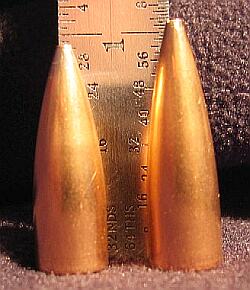 Bullet Weights and Profiles by Al Nyhus
Bullet Weights and Profiles by Al Nyhus
30BRs work best with bullets not exceeding 125 grains. Jacket lengths should be either .925" for the 110-112gr bullets or 1.00" for the 118-125s. Ogives can be either 7 or 10 tangent ogives, but be aware that the shorter .925" jackets require virtually no freebore length. The 'zero freebore' chambers can also be used with 1.00" bullets. I currently use a .030" freebore with the 1.00"-jacketed bullets and this works fine. Twist rates from 1:15 to 1:18 work well, with the edge going to the 1:17 and 1:18 versions at this point. A 1:15 twist rate allows use of the 125gr bullets built on 1.080" jackets, but the freebore may be too long if you wish to change to the shorter 1.00" bullets, especially if you prefer the 10-ogive models. I suggest setting your chamber and freebore up for the 1.00"-jacketed bullets, regardless of twist rate.
Photo L to R: BIB 112gr 7-ogive, BIB 118gr 10-ogive
Match-Winning Loads by Randy Robinett
Most people are using either H4198, or Vihtavuori N-130, with 110-125gr bullets. A few people have reported satisfactory results with some lots of AA2015, RL-7, and N-133 though I think N-133's burn rate is probably too slow. Most of the winning score and group aggs have been posted using H4198. H4198 is also more dense than N-130, so you can pack about .5 grains more in the case. Generally, with bullets of 118gr and lighter, a case full is not too much--that is with regard to pressure. Joe Entrekin and "Humble Henry" Rivers have collected a fair amount of hardware with this combination, Joe preferring the 118gr, 10-ogive. Dave Greene has won both group and score events, while using 125gr bullets. Craig Kostyshyn has done very well with the 112s: "I found my 30BR went from being good to great when I raised velocity to just over 3000 fps (with moly BIB 112s, in Kostyshyn 17-Twist 4-groove barrel"). I found precision with [H4198] but the N130 seemed to shoot even better."
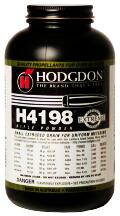 Most 30BR rigs display a "sweet spot" between 2950 fps and just under 3000 fps, then again at about 3050 fps. With 118gr bullets, my barrels deliver these velocities at, respectively, 32.7 grains and 34.8 grains of H4198. Interestingly my 24" HV barrel is only 25 fps faster than my 21" LV barrel. This was clocked with my old reliable Oehler chronogarph, with the screens centered 15' from the muzzle. The LV posted 3025 fps and the HV barrel 3052 fps (average for ten shots). This was with a charge weight of 34.8 grains H4198, 118gr bullets and WSR primers. Extreme Spreads were less than 20 fps - likely within the error range of the chronograph.
Most 30BR rigs display a "sweet spot" between 2950 fps and just under 3000 fps, then again at about 3050 fps. With 118gr bullets, my barrels deliver these velocities at, respectively, 32.7 grains and 34.8 grains of H4198. Interestingly my 24" HV barrel is only 25 fps faster than my 21" LV barrel. This was clocked with my old reliable Oehler chronogarph, with the screens centered 15' from the muzzle. The LV posted 3025 fps and the HV barrel 3052 fps (average for ten shots). This was with a charge weight of 34.8 grains H4198, 118gr bullets and WSR primers. Extreme Spreads were less than 20 fps - likely within the error range of the chronograph.
Joe Entrekin currently prefers H4198. He reports: "I think H4198 is the ticket. When I switched from VV N-130, everything got a little more consistent. Both powders produced very satisfactory SDs (6-7 fps over 10 shots), but the H4198 produced better results in actual matches."
Velocities and Efficiency by Al Nyhus
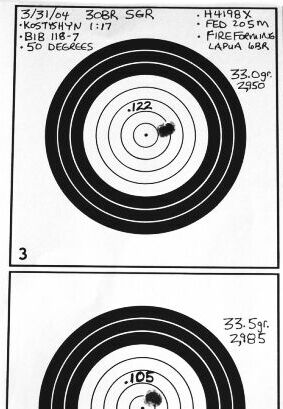 Using either N130 or H4198, with 112-125gr bullets, peak velocities will be in the 2950-3020 range. 30BRs seem to have multiple accuracy nodes, but 2980-3020 fps seems to favored by most tuners at this time. The 30BR's outstanding efficiency is what allows those impressive velocities. If you compare the capacity/bore ratios of the shortened .308 Win wildcats used in Hunter Benchrest shooting (45.0 grains and above) you'll find they have almost the same ratio as does the 6PPC. It's no surprise then that the 30BR is even more efficient, both because of its capacity/bore ratio and because of the case design and flash hole/primer configuration.
Using either N130 or H4198, with 112-125gr bullets, peak velocities will be in the 2950-3020 range. 30BRs seem to have multiple accuracy nodes, but 2980-3020 fps seems to favored by most tuners at this time. The 30BR's outstanding efficiency is what allows those impressive velocities. If you compare the capacity/bore ratios of the shortened .308 Win wildcats used in Hunter Benchrest shooting (45.0 grains and above) you'll find they have almost the same ratio as does the 6PPC. It's no surprise then that the 30BR is even more efficient, both because of its capacity/bore ratio and because of the case design and flash hole/primer configuration.
A Fast and Forgiving Cartridge
6BR shooters may be amazed at the speeds with which the 30BR can push 112-125gr bullets. After all, a standard 6BR case is hard-pressed to drive a 107gr SMK much past 2950fps even with a 30" tube. The 30BR's larger bore diameter is what makes that possible. Likewise, the capacity/bore ratio of the 30BR is what makes it such a tuneable cartridge. 30BRs don't display any bad manners over wide swings of temperature and humidity--a major point when temps change upwards of 40 degrees from morning relays to the afternoon relays.
| 30BR Load Map |
| Powder | Load Grains | Bullet | Velocity | Notes |
| Hodgdon 4198 | 34.7 | BIB 112 | 3050 fps | Bit Faster than 118s |
| Vihtavuori N130 | 34.7 | BIB 112 moly | 3000 fps | Kostyshyn Prefers N130 |
| Accurate AA2015 | 33.0+ | BIB 112 | 2950 fps | "Old" lots best |
| Hodgdon 4198 | 32.7 | BIB 118 | 2950 fps | Robinett Data |
| Hodgdon 4198 | 33.5 | BIB 118-7 | 2985 fps | Nyhus Load |
| Vihtavuori N130 | 34.3 | BIB 118 | 2950 fps | Accurate, Low SD |
| Hodgdon 4198 | 34.2 | BIB 118 moly | 3000 fps | Entrekin Match Load |
| Hodgdon 4198 | 34.8 | BIB 118 | 3052 fps | Robinett Data |
| Hodgdon Benchmark | 36.0 | Cheeks 118 | 2990 fps | Very Accurate |
| Hodgdon 4198 | 34.5 | BIB 125 moly | 3000 fps | Entrekin 125gr Load |
| WARNING: With all loads, ALWAYS START 10% LOW and work up incrementally. |
Barrels
There are outstanding 30BR barrels being built today by Hart, Kostyshyn, Krieger, Lilja, and Morrison among others. Al Nyhus loves his Lilja 1:17 3-grooves, and check out the target above to see how well Al's Kostyshyn tube shoots. The Kriegers of Joe Entrekin and Henry Rivers have shown exceptional accuracy and barrel life. Joe's barrel is still winning with 7400 rounds through it. Joe tells us: "You really can't go far wrong with a 30BR barrel from one of the name makers. Henry and I haven't seen a 30BR barrel yet that wouldn't shoot. Barrel life is phenomenal as well."
Barrel lengths from 21-24" work well, with the 24-inchers giving a very slight velocity edge, maybe 25-30 fps. As for twist rates, 1:17 and 1:18 barrels are winning the most matches. The 18-twist may have a slight accuracy edge, but Al Nyhus suggests sticking with a 1:17: "with the 1.00" jacketed bullets, a 1:17 is dandy and gives a bit of a safety net. A 1:18 is also great, but be aware that at least one well known barrel-maker's 18-twist 30BR barrels are actually about 1 in 18.25". When you run this close to the edge, bullet stability can get marginal in certain conditions". The 17- or 18-twist barrels also torque less than 1:15 barrels. This translates to easier gun-handling. Dick Grosbier explains: "the 17- and 18-twist barrels do not torque in the bags. They also do not copper-foul very much at all. Personally I believe 17- or 18-twist is the way to go. Craig Kostyshyn has only shot a 17 as far as I know and has a very enviable record with it. Both my Barrels are Kriegers as suggested by Joe and Henry."
30BR Barrel Life
One thing you DON'T have to worry about with the 30BR is barrel wear/round count. We polled all our experts about predicted 30BR barrel life. The consensus answer was "we can't say--nobody has worn one out yet!" While a 6.5-284 barrel for 1000-yard competition may be shot out after 900-1000 rounds, a good 30BR barrel will deliver five or six times that number--we estimate 5000 rounds for a button-rifled barrel, and upward of 7000 for a cut-rifled barrel, based on Joe's experience with his Kreiger.
Chambering and Reamers
You want to find a smith who is familiar with the round. Setting the freebore to match the jacket length is very important. Some shooters have had good success with a zero freebore set-up, and this requires very accurate chambering if it is to work right. There is no standardized 30BR chambering, but Dave Kiff at Pacific Tool & Gauge stocks a "30 Robinett" reamer. Dimensions can be customized to suit your bullet selection. Joe Entrekin uses the "Ronnie Long" Reamer from JGS. With either reamer source, we recommend sending in a couple of dummy rounds for the tool-maker to measure. Al Nyhus adds: "We like to see no more than a T.I.R. (total indicated runout) of .00015 (1.5 ten thousandths) on our chambers. It's vital that the bullet get as straight a start as possible into the lands and grooves, even though in most cases the bullets are seated to 'jam' into the lands. An excellent acuracy gunsmith with top notch equipment is needed to insure a proper chambering job. I've been fortunate to have Stan Ware (SGR Custom Rifles) doing all my chambering and metal work for quite a few years. Stan will take as much time as needed to achieve whatever goals the task at hand demands, as do many other fine accuracy gunsmiths. When it comes to chambers, 'close enough' is not good enough in my mind."
Quotable Quotes from 30BR Shooters
"What's the big Mystery?? You have the finest in Brass, (Lapua 6BR parent case). The chambering is obviously a good match between the bullet area and the case capacity. There are some excellent barrels being made for the 30 caliber. And it is common knowledge that the BIB Bullet is one of the most accurate pills made, when compared to ANYTHING, period." --Jackie Schmidt, on Benchrest.com
"My 30BR rifle and I won the 200 yard agg in the first registered group match that I attended with it. I believe the agg was a .2116. The load that I was [using] was 36 grains of Benchmark behind Ronnie Cheeks 118 grain bullets. Speedy, myself and a couple of other shooters had a blast shooting '1s' with that load on a practice day. I was impressed enough with the load to order 48 pounds of Benchmark and 8,000 of Ronnie's 118's." --Shelley Davidson
"My 30BR, 'UGLY' [is] a bucking bronco shooting free recoil, and it will not track like a 6 or a 22, period...It doesn't matter if I'm on the 4198, 33.3 node or the 34.5 node; it's still a handful, but it shoots! I wasted two full days at the range 'tuning' in cool to hot conditions. Neck tension and OAL doesn't matter and the charge nodes are wide enough to double park your 944. 118 and the 112s shoot the same. Again, YMMV but from my limited experience this is a 'load-it-up-and shoot' rifle and one of the most accurate rifles I have ever owned." --Ed Davis, on Benchrest.com
|
New Applications -- 30BR for Hunting and Tactical Use?
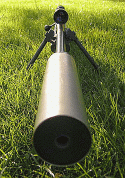 Currently, the 30BR is used almost exclusively for Benchrest competition. However, we think it has great potential for other applications given its inherent accuracy and superior efficiency. The 30BR can drive a 118gr bullet faster than the 6BR case can drive a 105gr bullet. In fact, the 30BR can push a 125gr bullet faster than a Rem 260 can drive a 123gr Scenar, despite using 10 grains less powder. Using suitable hunting projectiles, the 30BR is a viable deer-hunting round, with ballistics superior to the venerable 30-30. A 112gr bullet going 3000 fps is also going to make quick work of a coyote. In the tactical arena, the 30BR has much promise, because it can use .308 military bullets, and it can be downloaded to subsonic levels. In a rifle equipped with a sound suppressor, the 30BR could be a very effective "stealth" weapon.
Currently, the 30BR is used almost exclusively for Benchrest competition. However, we think it has great potential for other applications given its inherent accuracy and superior efficiency. The 30BR can drive a 118gr bullet faster than the 6BR case can drive a 105gr bullet. In fact, the 30BR can push a 125gr bullet faster than a Rem 260 can drive a 123gr Scenar, despite using 10 grains less powder. Using suitable hunting projectiles, the 30BR is a viable deer-hunting round, with ballistics superior to the venerable 30-30. A 112gr bullet going 3000 fps is also going to make quick work of a coyote. In the tactical arena, the 30BR has much promise, because it can use .308 military bullets, and it can be downloaded to subsonic levels. In a rifle equipped with a sound suppressor, the 30BR could be a very effective "stealth" weapon.
Sako TRG-22 Photo by Terje (Norway)
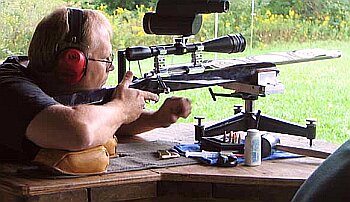 Contributor Profiles
Contributor Profiles
"Smokin Joe" Entrekin is one of the pioneers of 30BR competitive shooting. He was 2003 IBS Score Shooter of the Year. In 2004 he won the 100/200 yard Score Nationals, won many regional matches, and was runner-up for Score Shooter of the Year. In "real life", Joe is a mechanical engineer who operates his own BMW/Mercedes service facility in Augusta, GA.
Al Nyhus (shown above at the bench) is the 2003 IBS Hunter Class Champion. Al lives in Sioux Falls, South Dakota. While not exactly the Mecca of Benchrest shooting at first glance, further investigation will reveal a very active Benchrest shooting region. Both IBS and NBRSA sanctioned ranges are in the area, the most notable being at Webster City, IA, Van Dyne, WI, Holmen, WI, and Desoto, KS. Al primarily competes in the Hunter Benchrest class.
Randy Robinett, a true "Founding Father" of the modern 30BR, runs BIB Bullets. Randy's 30-caliber bullets are used by the overwhelming majority of 30BR competitors. Randy is also an avid shooter who campaigns the 30BR in Registered 100-yard and 200-yard Benchrest matches.
 BIB Bullet Co. (R.G.Robinett)
P.O. Box 72
Madrid, IA 50156
bibrob@iowatelecom.net
Phone: (515) 795-2906
BIB Bullet Co. (R.G.Robinett)
P.O. Box 72
Madrid, IA 50156
bibrob@iowatelecom.net
Phone: (515) 795-2906
Topics: 30BR History, 30BR Testing, 30BR Competition, 30BR Case-forming, 30BR Reloading, 30BR Bullets, .08 Bullets, 30BR Dies, 30BR Lapua brass, 30BR Barrels & Chambering, 30BR Gunsmiths, 30BR NBRSA & IBS Matches, Hodgdon H4198 and Vihtavuori N130 powder, 7mm BR Remington, 30BR Hunting & Varminting, Neck-Turning, Recommended 30BR Load Recipes.
Copyright ? 2004, 6mmBR.com, All Rights Reserved. Photos courtesy Hodgdon Powder, Jim De Kort, Alan Nyhus, Randy Robinett, used by permission, All Rights reserved by them. No reproduction without advanced permission in writing.
